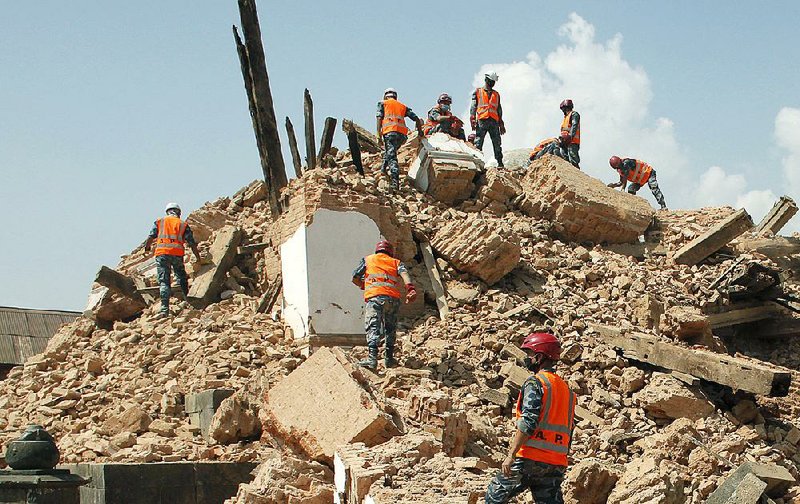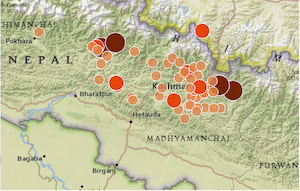KATHMANDU, Nepal -- A week after a devastating earthquake leveled many areas of Nepal, the U.S. military is sending up to 500 troops, plus aircraft and equipment, to help deliver supplies that have been stuck at the tiny country's main airport.
The supplies have been pouring in from around the world but have been slow to reach victims in Kathmandu, the capital, as well as smaller towns and villages.
The magnitude-7.8 quake that struck April 25 killed more than 7,040 people and left hundreds of thousands homeless, many stranded in remote areas, some of which have yet to receive help.
The death toll is expected to climb even as search-and-rescue operations begin to wind down this week, a Nepal army official said.
Three U.S. flights scheduled to arrive late Saturday were delayed, according to U.S. and Nepalese officials.
The expanded U.S. military involvement is aimed at relieving the backlog of supplies that have piled up at Kathmandu's Tribhuvan International Airport, and taking relief shipments to distribution points across the country, officials said.
Officials said the response mirrors the relief operation in 2005 in Pakistan after an earthquake that killed 86,000 people. Nepal's high-altitude, mountainous terrain, most of it inaccessible by road, is similar to that of the quake-affected areas of Pakistan.
Among the first U.S. aircraft to arrive, perhaps as early as today, will be four vertical-takeoff Osprey aircraft, which will be joined by Army Chinook helicopters and C-130 cargo planes, said Marine Corps Brig. Gen. Paul Kennedy, commander of the operation.
U.S. forces also will bring in forklifts to better manage the shipments at the airport, which has only one runway and has been severely congested in the week since the quake.
Already, 25 U.S. service members have created an operations center on U.S. Embassy-owned grounds in central Kathmandu. Military personnel will be housed in tents and at forward staging bases across the country. Some of those sites are operated by the Nepalese military, which has long had close ties to U.S. forces.
"This wasn't an unknown that this earthquake would happen. We've been preparing for it and planning for it," said Bill Berger, head of disaster response for the U.S. Agency for International Development, which is leading the U.S. effort.
The flights will take off and land from Tribhuvan airport as well as several smaller airstrips and helicopter landing zones around the country, Kennedy said. U.S. aircraft are not expected to deliver goods directly to towns or villages but instead will take them to distribution points where Nepalese authorities and international aid agencies will take charge.
"We'll fill a niche and then will be supplanted by the professionals," Kennedy said.
The operation has added urgency because of the coming monsoon season, when remote areas become even less accessible, said Berger, who has worked in Nepal for 18 years.
The United Nations has said that 8 million of Nepal's 28 million people were affected by the quake. At least 2 million are expected to need tents, water, food and medicine during the next three months.
Nepal's military welcomed the U.S. assistance Saturday--which came just in time, said Nepal army Col. Anand Kumar Adhikari.
"Desperately we need support. People in remote areas, especially where roads are blocked by landslides, that has to be supported," Adhikari said from his headquarters at the airport, surrounded by white boards listing dozens of countries that have sent aid and military and civilian assistance, including search-and-rescue teams.
Of the country's 75 districts, 34 suffered some damage, he said. In the case of 14 districts, the devastation was severe.
"The critical part now is to deliver relief items" from the 40 tons they have amassed, he said, including ready-to-eat meals, but mostly nonfood supplies they plan to drop from aircraft in remote areas until roads can be cleared.
It's unclear how soon the country and capital will recover.
Kathmandu's largest tent city of displaced residents, Tundikhel, has shrunk from 12,000 to 2,300 residents as those who could left for outlying areas, in some cases fearing further tremors. Many who remained Saturday said they had nowhere else to go.
Junu Sundash, 19, grew up in an orphanage, then trained as a beautician to help raise her disabled 15-year-old brother before the quake destroyed their apartment building and left them sharing a tent in the camp with 18 others. The mall where she works is still closed due to quake damage. She doesn't plan to leave her tent any time soon.
"I just want to be able to work at the beauty parlor and help my brother," she said.
As concern spread about sanitation, Kathmandu authorities banned meat, hoping to prevent disease. They urged residents to wear protective masks, already widely used near quake-damaged buildings, to block the dust and stench.
A Section on 05/03/2015

